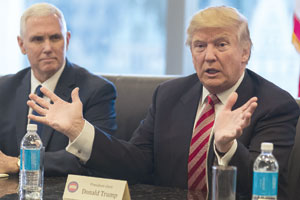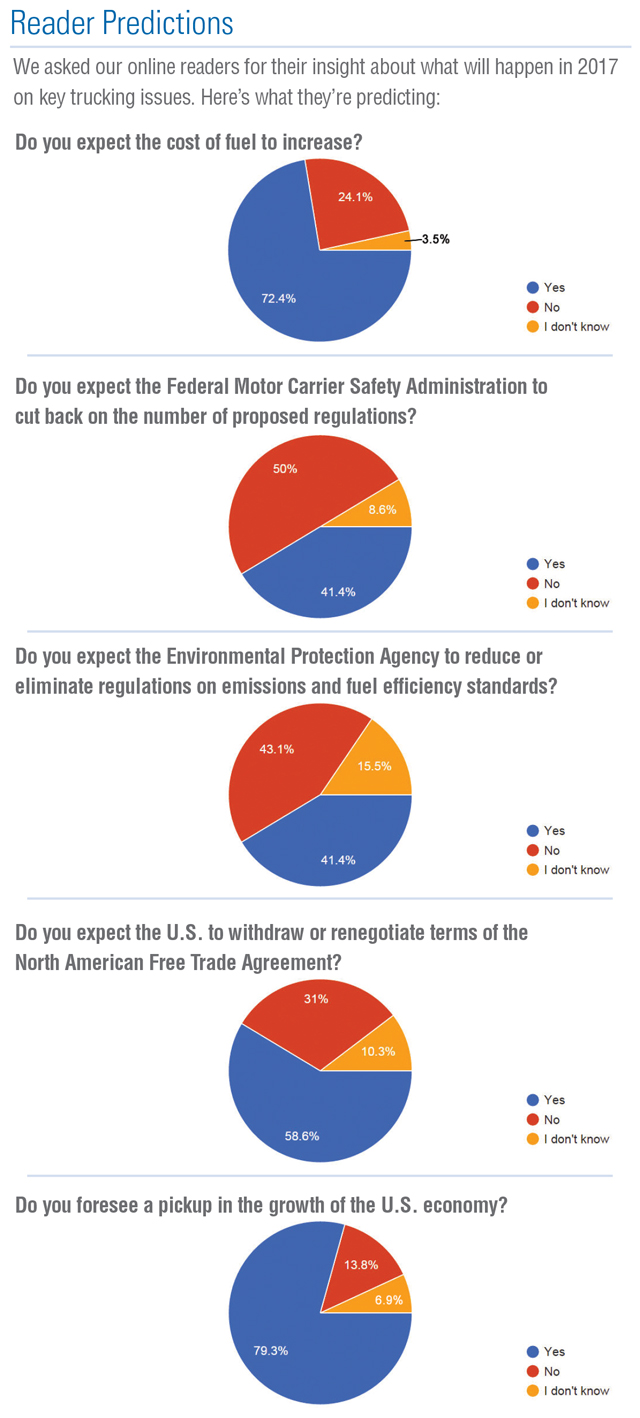2017 Year in Preview: ‘Expect the Unexpected’ for Trucking, Nation

This story appears in the Jan. 2 print edition of Transport Topics.
Uncertainty dominates the outlook for trucking and freight transportation in 2017.
Although expectations are that the economy will continue to expand, and maybe even pick up steam, much of what happens in the next year will depend on how much of President-elect Trump’s campaign rhetoric is translated into policy and the extent to which Congress will support cutting back on regulation and increasing spending on infrastructure.
Will Trump really try to rework the North American Free Trade Agreement? Will the new administrator of the Environmental Protection Agency reverse course on reducing emissions and imposing fuel-efficiency standards for trucks? Will spending on infrastructure increase? Will taxes go down? What will replace Obamacare?
2016 YEAR IN REVIEW: Timeline, top cartoons, top stories and more
In a recent online presentation to clients, Larry Gross of FTR Transportation Intelligence prefaced his remarks by saying, “Expect the unexpected.”
The election will have huge implications across all modes of freight transportation, Gross said, but what exactly that will look like remains to be seen.
“We have someone appointed to head the Environmental Protection Agency who doesn’t believe in regulation of the environment,” Gross said. “Will we see dramatic change that will affect coal and oil drilling? Is the so-called ‘war on trucking’ over? Will we see a boost in the economy, a lower tax rate, an infrastructure spending plan? These are hugely important questions that we don’t have good answers for.”
Gross’ advice: Have a contingency plan and be prepared to make adjustments to whatever happens.

One thing most people seem to agree on is that business will improve, at least in the short run.
Equity research analyst Michael Baudendistel of Stifel, Nicolaus & Co. raised target prices for stocks of companies that make transportation equipment, in part, because of “optimism that the incoming administration could be a positive for general corporate interests as well as many of the end markets served by transportation equipment companies, including energy, infrastructure and manufacturing.”
The economy has been on an upward track since June 2009, marking the fourth-longest period of business expansion on record, according to data from the National Bureau of Economic Research and reported by MacKay & Co., an industry research firm.
“We expect that fact not to be lost on the new administration and strongly suspect that the actions they will be proposing will be designed to protect and promote the longevity of this phase of the business cycle,” the company stated in a recent report to its clients.
Bob Costello, chief economist for American Trucking Associations, said he expects U.S. gross domestic product to rise 2.2% in 2017, a slight increase from his forecast of 1.5% growth in 2016, but lower than growth rates experienced in 2014 and 2015.
Costello said he is prepared to boost his forecast of economic growth depending on what we see in terms of infrastructure spending, tax reform and regulatory relief. “Forecasting has gotten more difficult,” he said, but added, “Things are pointing in the right direction.”
“I have a lot of optimism,” said Marcia Faschingbauer, president of Excargo Services in Houston. “What I hope to see is a little bit more right-sizing of government and reining in of administrative constraints. I’m also optimistic about our tax burden being lightened a bit.”
As a drayage carrier whose business depends almost entirely on freight coming into and going out of U.S. ports, Faschingbauer said she does not want to see the Trump administration do anything that would curtail international shipping or to make it more difficult for companies to employ immigrants. She does favor an effort to make trade deals fairer and to help attract younger people, veterans and women to become drivers.
On her wish list for changes to Obama-era regulatory policies are a stop to the crackdown on the use of owner-operators and potentially costly rules for motor carriers to treat drivers with sleep apnea.
Bill Sullivan, executive vice president and chief lobbyist for ATA, said it is possible that the new administration will try to scuttle the Phase 2 greenhouse-gas emission standards recently set by the EPA and the National Highway Traffic Safety Administration. The new administration could also take steps to stop other prospective regulations, such as the current proposal by the Federal Motor Carrier Safety Administration and NHTSA to require speed limiters on all new trucks.
Sullivan said he expects no change in the electronic logging requirement slated to take effect in December.
Industry experts expect the wider use of electronic logs will lead to capacity reductions as some firms exit the market rather than comply. Drivers who switch to ELDs from paper logs also will experience some loss of productivity as it become more difficult for truck drivers to fudge the number of hours they spend behind the wheel and hence the number of miles they can cover between rest breaks.
“2017 has the potential to be a very, very exciting year for large, well-capitalized, strategically positioned, compliant carriers,” Richard Stocking, CEO of Swift Transportation, said in a recent earnings call with investors. “As the clock winds down towards the deadline for ELD implementation, and potentially speed limiters as well, we are likely to experience a meaningful capacity contraction, which we believe will have a positive impact on the rate environment for carriers.”
Stocking said shippers are signaling that they expect to see rate increases in the mid- to upper single digits in the second half of the year.
Swift, which is based in Phoenix, ranks No. 6 on the Transport Topics Top 100 list of the largest for-hire carriers in the United States and Canada.
Todd Fowler, director and equity research analyst at Keybanc Capital Markets, said while he’s not as optimistic as Stocking is about rate increases, there is clear evidence that the adoption of ELDs will reduce the ability of carriers to haul as much freight.
In a study of publicly owned fleets, Fowler said carriers lost between 4% and 7% utilization after adopting ELDs. Some fleets gained back some utilization through efficiency, but over a two-year period, the carriers lost an estimated 3% to 5% of their effective capacity.
“In an environment that’s more in balance now, even 1% of capacity coming out, particularly in a stronger demand environment, we would think would be enough to move the needle,” Fowler said.
Another issue for fleets in 2017 is insurance premiums, which could rise between 10% and 30%, Fowler noted.
“We think that could accelerate some of the attrition that we’re seeing within the industry as we go through the licensing period in the first part of the year,” he said.
ATA’s Sullivan said he expects FMCSA to continue working on revisions to the Compliance, Safety, Accountability program in which drivers and carriers are rated based on results of roadside inspections and crash data, along with a new method of determining the safety fitness of motor carriers. However, Sullivan also said he expects there to be a slowdown, or perhaps even a moratorium, on new regulations until newly appointed administrators have a chance to look at the proposed rules with a “new set of eyes.”
On trade, Sullivan said the trucking industry would push back hard on any changes to the North American Free Trade Agreement that would disrupt the flow of goods to and from Mexico.
Although the president-elect has promised to penalize companies that shift manufacturing operations to Mexico and other low-cost countries outside the United States, at least one trucking executive doesn’t think it will make a huge difference.
“U.S. companies will continue to invest in China,” said Jack Griffin, CEO of Atlas World Group, which ranks No. 39 on the for-hire TT100. “I don’t see the U.S. becoming overly protectionist.”
A number of companies, in fact, have gone ahead with plans to open new plants and expand manufacturing in Mexico.
Germany-based HBPO, which makes consoles and front-end modules for cars, opened a new facility in San Jose Chiapa, Mexico, to support assembly of Audi’s Q5 luxury sport utility vehicle. The company also has production facilities in Windsor, Canada, and in Puebla and Toluca in Mexico.
Bendix Commercial Vehicle Systems, based in Elyria, Ohio, also recently doubled its capacity to make solenoid valves and manifolds at its plant in Acuna, Mexico. The plant, established in 1988 to serve customers in the U.S., Mexico and Canada, employs nearly 1,400 workers and is considered one of the top-ranked factories in the world by Bendix’ corporate parent, The Knorr-Bremse Group.
For manufacturers of truck equipment, sales of new Class 8 tractors and trailers are projected to decline in the year ahead as fleets continue to hold off on expanding capacity.
A forecast published by Kenny Vieth of ACT Research Co. projects U.S. Class 8 sales of 154,000 units in 2017 compared with 201,000 units in 2016 and a record 253,000 units in 2015. For trailers, Vieth is calling for sales of 241,000 units in 2017, compared with 283,000 units in 2016 and a record 308,000 units in 2015.
Steven Szakaly, chief economist for the National Automotive Dealers Association, predicts sales of 17.1 milllion new cars and light trucks in 2017, a slight decline from 2016, but still near the record set in 2015.
“We are headed toward a stable market for U.S. auto sales, not a growing market,” Szakaly said. “It’s important to recognize that there are some political unknowns. … If increased infrastructure spending happens and certain tax cuts materialize under the new administration, it will mean a better long-term outlook.”

